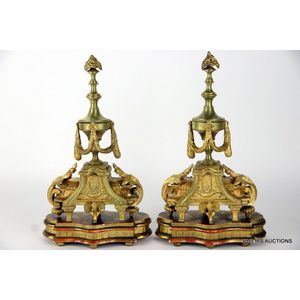Louis XVI Style Ormolu Mantle Urns
You must be a subscriber, and be logged in to view price and dealer details.
Subscribe Now to view actual auction price for this item
When you subscribe, you have the option of setting the currency in which to display prices to $Au, $US, $NZ or Stg.
- Acanthus - A stylized leaf motif, one of the primary decorative elements of classical Greek and Roman architecture, derived from the genus of flowering plants in the family Acanthaceae, native to tropical and subtropical regions of the Mediterranean area. It is a common element in classical Greek and Roman design, and is often seen in Corinthian and Composite order columns and used as a decorative element in English, European and Australian furniture, particularly on the curve of a leg, and as decoration for a corbel.
- Giltwood - Giltwood is used to describe a gold finish on furniture and other decorative wooden items, whereby a thin sheet of gold metal, called gold leaf, is applied to the surface for decorative purposes.
Unlike gilding, where the gold leaf is applied over a coating of gesso, with giltwood the gold leaf is applied direct to the surface, or over a coat of linseed oil gold leaf adhesive.
Most gold-finished mirrors will be gilded, whereas furniture with gold highlights will have the gold applied through the giltwood method. - Ormolu - Ormolu was popular with French craftsmen in the 18th and 19th century for ornamental fittings for furniture, clocks and other decorative items. True ormolu is gilt bronze, that is bronze that has been coated with gold using a mercury amalgam. Due to the health risks associated with using mercury, this method of creating ormolu was discontinued in France in the 1830s. A substitute was developed consisting of about 75% copper and 25% zinc, however it was inferior to the bronze version. It was often lacquered to prevent it tarnishing.
This item has been included into following indexes:
Visually similar items


A Victorian horn and silver walking cane, 1888 Birmingham, with maker's mark WM, the tapering malacca cane shaft with a scrolled silver ferrule surmounted by a cream brown mottled bone handle well carved with a pair of mice; hallmarked. Length 85 cm

18ct yellow gold, stone set ring approx 3.4 grams, size M-N / 6

English modern sterling silver goblet, hallmarked, London, 1978, Wakely & Wheeler, with bell shaped bowl, above gilt textured and fluted support on hexagonal foot, height 14 cm
